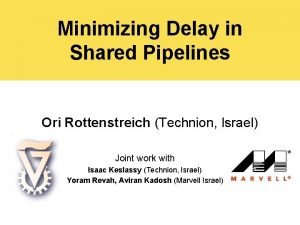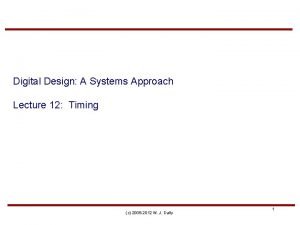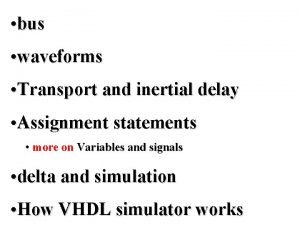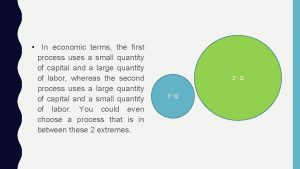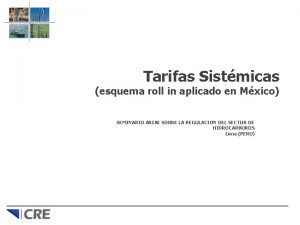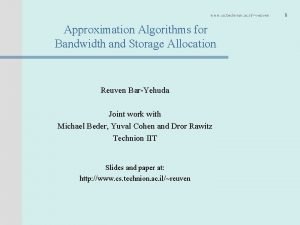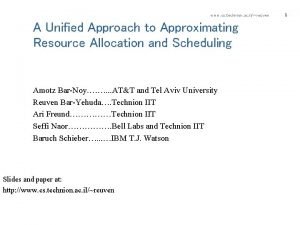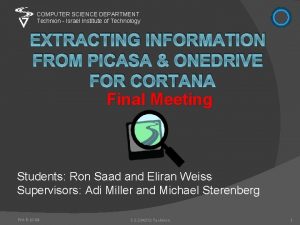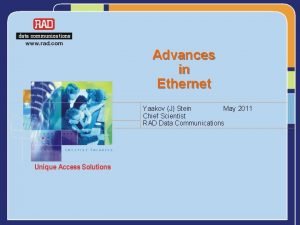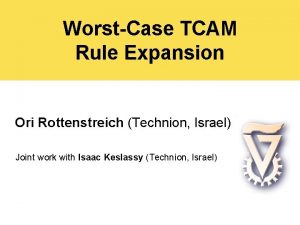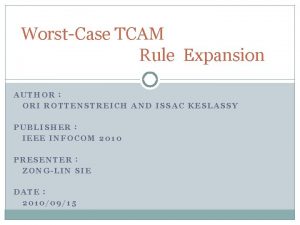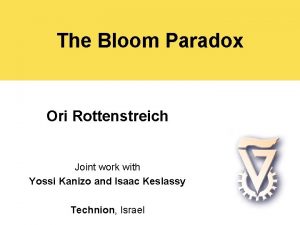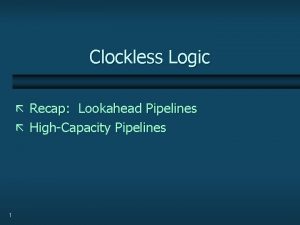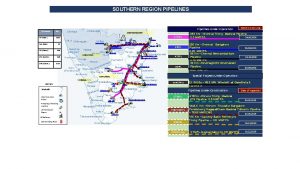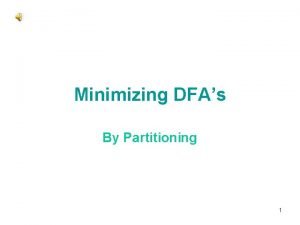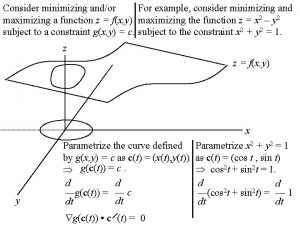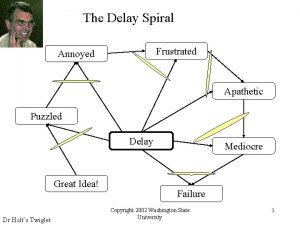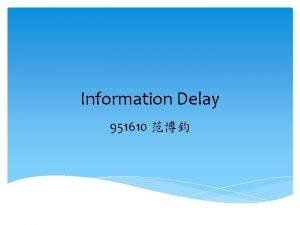Minimizing Delay in Shared Pipelines Ori Rottenstreich Technion










![Simple Case of the Required Tasks: Si = [1, Xi] • We suggest an Simple Case of the Required Tasks: Si = [1, Xi] • We suggest an](https://slidetodoc.com/presentation_image/6fa3f561084541e04cdf03f5e968bd3c/image-11.jpg)
![Simple Case of the Required Tasks: Si = [1, Xi] • Proposition: Assume that Simple Case of the Required Tasks: Si = [1, Xi] • Proposition: Assume that](https://slidetodoc.com/presentation_image/6fa3f561084541e04cdf03f5e968bd3c/image-12.jpg)
![Simple Case of the Required Tasks: Si = [1, Xi] • Let (for ) Simple Case of the Required Tasks: Si = [1, Xi] • Let (for )](https://slidetodoc.com/presentation_image/6fa3f561084541e04cdf03f5e968bd3c/image-13.jpg)











- Slides: 24

Minimizing Delay in Shared Pipelines Ori Rottenstreich (Technion, Israel) Joint work with Isaac Keslassy (Technion, Israel) Yoram Revah, Aviran Kadosh (Marvell Israel)

Pipeline Sharing for H. 264 video-compression standard 9 profiles with 21 features are organized in 9 pipelines in a 9 x 9 multicore scalability problem: more profiles, more features more cores 2

Pipeline Sharing for H. 264 video-compression standard 1 4 8 9 10 21 14 13 12 11 20 19 18 17 16 9 profiles with 21 features are organized in 9 pipelines in a 9 x 9 multicore 6 7 13 14 15 5 4 3 2 1 Pipeline Sharing: The 9 profiles are serviced by one of two possible pipelines in a smaller 5 x 5 multicore 3

Another Pipeline Sharing Example • Regular architecture, without pipeline sharing: o 3 pipelines for the k=3 (uniformly distributed) packet types with N=8 cores o Average delay of T=(3+2+3)/3≈2. 67 time slots • With pipeline sharing: o 2 pipelines for the k=3 packet types with only N=6 cores o Average delay of T=(4+2+4)/3≈3. 33 time slots o Tradeoff: Less cores, larger average delay 4

Model and Problem Definition • Traffic: o There are k packet types with known probabilities, each requires to perform tasks among {1, …, r } possible tasks o Example: Type 1 w. p. p 1=0. 6 requires tasks S 1={1, 2, 3} and Type 2 w. p. p 2=0. 4 requires tasks S 2={1, 4} • Pipeline sharing: o o o A limited number of N homogeneous cores is given. Each core can serve any task The cores should be divided into pipelines, each serves one or more packet types The delay of a packet equals the length of its pipeline • Optimization Problem: o o Divide the N cores into pipelines, such that the average delay is minimized For a given N, we denote by TOPT(N) the minimal possible average delay 5

Outline Ø Introduction and Problem Definition Ø General Properties Ø Optimal Algorithm for a Special Case Ø Greedy Algorithm Ø Experimental Results Ø Summary 6

General Properties Average delay (TOPT(N)) (ii) (iii) Number of cores (N) • Property: (i) At least (ii) For all (iii) cores are required the optimal average delay satisfies for 7

General Properties • Property: Let k be the number of packet types. Then, (i) Given an unlimited number of cores, the number of solutions with d pipelines is given by where , is the Stirling number of the second kind of k, d (ii) The total number of solutions is • Example: Consider k=3 packet types There is a single solution with 1 pipeline: There are solutions with 2 pipelines: There is solution with 3 pipelines: The total number of solutions is 8

Separability • Property: Assume that packet types can be partitioned into two disjoint sets, i. e. they can be ordered s. t. Then, s. t. an optimal solution given N cores can be obtained as the union of the two sets of pipelines in the optimal solutions for packet types [1, m] with N 0 cores and for packet types [(m+1), k] with (N-N 0) cores. • Proof Outline: Any pipeline in an optimal solution cannot serve tasks from both sets Otherwise, it could be partitioned into two smaller pipelines to reduce the average delay. 9

Outline Ø Introduction and Problem Definition Ø General Properties Ø Optimal Algorithm for a Special Case Ø Greedy Algorithm Ø Experimental Results Ø Summary 10
![Simple Case of the Required Tasks Si 1 Xi We suggest an Simple Case of the Required Tasks: Si = [1, Xi] • We suggest an](https://slidetodoc.com/presentation_image/6fa3f561084541e04cdf03f5e968bd3c/image-11.jpg)
Simple Case of the Required Tasks: Si = [1, Xi] • We suggest an optimal algorithm for a special case of the sets of required tasks: for • Example: k=3, • The condition is equivalent to the requirement • Assume that are ordered s. t. • Let for be the sets of tasks served by the pipelines in an optimal solution • Proposition: The pipelines in an optimal solution satisfy , i. e. the pipelines in the solution are among the pipelines in the input 11
![Simple Case of the Required Tasks Si 1 Xi Proposition Assume that Simple Case of the Required Tasks: Si = [1, Xi] • Proposition: Assume that](https://slidetodoc.com/presentation_image/6fa3f561084541e04cdf03f5e968bd3c/image-12.jpg)
Simple Case of the Required Tasks: Si = [1, Xi] • Proposition: Assume that are ordered such that Then, (i) The packet types are served by an increasing order of pipelines. In particular, the packet types served by each pipeline form a subset of consecutive packet types from the input. (ii) The last packet type is served by the last pipeline. 12
![Simple Case of the Required Tasks Si 1 Xi Let for Simple Case of the Required Tasks: Si = [1, Xi] • Let (for )](https://slidetodoc.com/presentation_image/6fa3f561084541e04cdf03f5e968bd3c/image-13.jpg)
Simple Case of the Required Tasks: Si = [1, Xi] • Let (for ) be the minimal possible average delay obtained in the service of the first i types with at most n cores. Let be the corresponding set of pipelines. • Proposition: (i) For (ii) For j that minimizes (i), • Algorithm: o In step i (for o Return: o Complexity: ), calculate (optimal delay), (set of pipelines) 13

Outline Ø Introduction and Problem Definition Ø General Properties Ø Optimal Algorithm for a Special Case Ø Greedy Algorithm Ø Experimental Results Ø Summary 14

Pipeline Merging Algorithm • Idea: Start with a pipeline for each type, merge pairs of pipelines with common cores • p 1 p 2 p 3 Intuition: For each pair with common cores, we prefer to merge o More common cores o Less non-common cores o Low probability to be served by a pipeline in the pair • Marginal cost of a possible merging operation o x – expected increment in the average delay o y – decreased number of cores o Marginal cost of R=x/y • Algorithm: Until the required number of cores is obtained, merge pairs of pipelines with minimal marginal cost R=x/y • Not necessarily optimal but very efficient on synthetic and real-life applications 15

Experimental Results • Synthetic Simulation Parameters: o We consider k=8 packet types o Tasks selected among r =10 possible tasks {1, …, r =10} o Each type requires a specific task w. p. 0. 5 without any dependency between different types or tasks o Two options for the packet types probabilities: q fixed prob. – all types w. p. 1/k = 0. 125 q variable prob. – geometrically decreasing probabilities of 2 -1, 2 -2, 2 -3, 2 -4, 2 -5, 2 -6, 2 -7 and 2 -7 o Results are based on the average of 103 iterations 16

Experimental Results Less cores larger delay A lower bound: Average number of tasks per type 10∙ 0. 5=5 Maximal observed total number of tasks • Effectiveness of the number of cores on the average delay in time slots. k=8 packet types with r =10 possible tasks, each required w. p. 0. 5 by each type. 103 iterations. 17

Experimental Results A difference of less than 2% 16 cores instead of 60, delay of 8. 47 / 8. 11 time slots instead of ~5 • Summary of the synthetic simulations. k=8 packet types with r =10 possible tasks, each required w. p. 0. 5 by each type. 103 iterations. 18

Packet-processing Application • Possible Tasks: (1) Parsing, (2) Ingress interface attributes, (3) Ingress ACL, (4) L 2 bridging, (5) L 3 routing, (6) L 3 replication, (7) MPLS switching, (8) header modification, (9) L 2 replication, (10) Egress interface resolution, (11) Egress ACL 19

Packet-processing Application The greedy algorithm obtains the optimal delay in 16 out of 18 values of N. total number of tasks • k=5 packet types w. p. (0. 25, 0. 15, 0. 2, 0. 3, 0. 1) and r =11 possible tasks. The total number of solutions is G(5) = 52. The greedy algorithm starts with 28 cores, then reduces it to 24, 20, 15 and finally 11. It obtains the optimal delay in 16 out of 18 values of N. 20

H. 264 video-compression standard 1 4 8 9 10 21 14 13 12 11 20 19 18 17 16 9 profiles with 21 features are organized in 9 pipelines in a 9 x 9 multicore 6 7 13 14 15 5 4 3 2 1 Pipeline Sharing: The 9 profiles are serviced by one of two possible pipelines in a smaller 5 x 5 multicore 21

H. 264 video-compression standard 25 instead of 75 cores, delay larger by 64% 49% less cores, delay larger by only 21% total number of features • k=9 popular (uniformly-distributed) profiles (types) of the H. 264 standard with r =21 supported features (tasks). Results are based on the greedy algorithm. 22

Concluding Remarks • New approach of sharing pipelines to reduce the number of required cores • Analysis of the optimal average delay • Optimal solution for • Greedy algorithm for the general case 22

Thank You
 Ori rottenstreich
Ori rottenstreich Ori rottenstreich
Ori rottenstreich Ori rottenstreich
Ori rottenstreich Ori rottenstreich
Ori rottenstreich Normally open, timed-closed contact symbol
Normally open, timed-closed contact symbol Propagation delay and contamination delay
Propagation delay and contamination delay Difference between signal and variable in vhdl
Difference between signal and variable in vhdl Cost minimization formula
Cost minimization formula Cost minimizing rule
Cost minimizing rule Dgix datei
Dgix datei Gdd
Gdd Pipelines
Pipelines Questar pipelines
Questar pipelines Tom coolidge
Tom coolidge Westwood pipelines
Westwood pipelines Technion
Technion Electrical engineering technion
Electrical engineering technion Technion
Technion Technion onedrive
Technion onedrive Autodiscover.csf.technion.ac.il
Autodiscover.csf.technion.ac.il Technion aerospace
Technion aerospace Technion
Technion Michael silverstein technion
Michael silverstein technion Agrisnetodisha.ori.nic.in
Agrisnetodisha.ori.nic.in Ana instruction in 8085
Ana instruction in 8085



